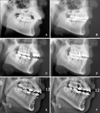Abstract
Objective
Methods
Results
Figures and Tables
 | Figure 1A first premolar extraction case using the lingual biocreative therapy. A and D, Lingual en masse retraction forces are initiated. B and E, Seven months of en masse retraction. Triangular elastics were applied to the canine for vertical control. C and F, Post-treatment. The total treatment period was 13 months. |
 | Figure 2A second premolar extraction case using the lingual biocreative therapy. A to C, Pre-treatment photos show dens evaginatus on #15 and a malformed #25. D to F, One month after en masse retraction force is initiated. G to I, Four months of en masse retraction. |
 | Figure 3Pre- and post-lateral cephalograms. A and B, Low lingual anterior retraction hook (LARH) - the patient needed controlled lingual tipping; hence, a LARH vertical height of 4 mm was used. C and D, High LARH - the patient needed bodily tooth movement; thus, a LARH vertical height of 13 mm was used. E and F, Second premolars were extracted due to internal resorption, so the 8 anterior teeth were retracted using the lingual biocreative therapy. |
 | Figure 4Three-dimensional finite element mesh with teeth, periodontal ligament, alveolar bone of the maxillary dentition, and C-retractor with the low lingual anterior retraction hook (LARH). |
 | Figure 5Schematic representation of the coordinate system of the lingual biocreative therapy with the low lingual anterior retraction hook (LARH) at different positions. A, Condition 1: the LARHs, made of 0.9-mm round stainless steel, were placed between the upper central and lateral incisors with 6° of toe in angle. B, Condition 2: the LARHs were placed between the lateral incisors and canines with 15° of toe in angle. C, Condition 3: the LARHs were placed between the upper central and lateral incisors after second premolar extraction. D, Condition 4: the LARHs were placed between the lateral incisors and canines with 15° of toe in angle after second premolar extraction. |
 | Figure 6Comparison of the effects of the different lengths and positions of the low lingual anterior retraction hooks (LARHs) in the C-retractor in the three dimensional finite element model. Tooth axies graph (incisor, midpoint of incisal edge to root apex; canine, cusp tip to root apex) magnified tooth displacement 70 times. Solid line means before displacement and a dotted line means after displacement (circles, central incisor; squares, lateral incisor; canine, triangles). Condition 1, The LARHs were placed between the upper central and lateral incisors after first premolar extraction. Condition 2, The LARHs were placed between the upper lateral incisors and canines after first premolar extraction. Condition 3, The LARHs were placed between the upper central and lateral incisors after second premolar extraction. Condition 4, The LARHs were placed between the upper lateral incisors and canines after second premolar extraction. |
 | Figure 7Comparison of the vertical effects (Z-axis) of the different heights and positions of the low lingual anterior retraction hooks (LARHs) in the three dimensional finite element model. |
 | Figure 8Comparison of the sagittal effects (Y-axis) of the different heights and positions of the low lingual anterior retraction hooks (LARHs) in the three dimensional finite element model. |
 | Figure 9
A, When the lingual anterior retraction hook is located distal to the central incisors (condition 1 or 3). B, Part of the extraction space is closed by C-retractor. C, The canine can be segmented from the C-retractor for detailing. D, Incisors and canines are decrowded with conventional bracket system. |
Table 2

Positive figures mean tooth intrusion and negative figures mean extrusion. Condition 1, The lingual anterior retraction hooks (LARHs) were placed between the upper central incisors and lateral incisors 6° of toe in angle. Condition 2, The LARHs were placed between the lateral incisors and canines with 15°of toe in angle. Condition 3, The LARHs were placed between the upper central incisors and lateral incisors after second premolar extraction. Condition 4, The LARHs were placed between the lateral incisors and canines with 15°of toe in angle after second premolar extraction.
Table 3

Positive figures mean tooth procline and negative figures mean retraction. Condition 1, The lingual anterior retraction hooks (LARHs) were placed between the upper central incisors and lateral incisors 6° of toe in angle. Condition 2, The LARHs of were placed between the lateral incisors and canines with 15°of toe in angle. Condition 3, The LARHs were placed between the upper central incisors and lateral incisors after second premolar extraction. Condition 4, The LARHs were placed between the lateral incisors and canines with 15°of toe in angle after second premolar extraction.




 PDF
PDF ePub
ePub Citation
Citation Print
Print



 XML Download
XML Download